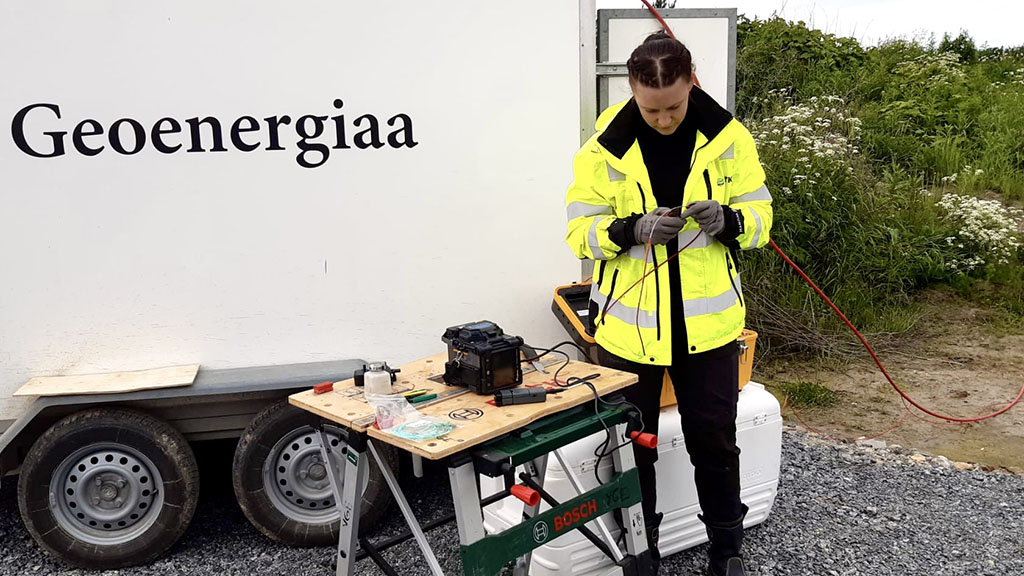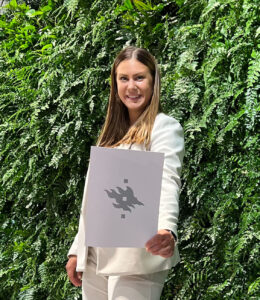Using Mineralogy in Identifying the Geothermal Energy Potential Cost-Effectively and Ecologically
Meri Wiberg completed her Master’s thesis in geology while working at the Geological Survey of Finland GTK. Newly graduated, she now sheds light on the things that helped her combine work and thesis-writing and select the topic for her research: “With my research, I wanted to lower the threshold of observing the geothermal energy potential, striving to tangibly advance the utilisation of geothermal energy in Finland. This goal inspired and guided me in my research.”

Working at GTK during the thesis-writing process has been a very positive experience. Working on the geothermal energy potential, conducting research, and comparing methods have significantly increased my professional competence. A team that supports collaboration, flexibility, and guidance have been instrumental in ensuring the success of my thesis.
The interest and support of my workplace community have been a huge driver for me in advancing my research, and I was eager to share new information and knowledge with my colleagues. My team has unique expertise in geothermal energy, and following their work has made my own work feel equally meaningful. The thesis-writing process was also important for me as it represented my first actual, self-produced and self-implemented scientific study on an interesting, topical and important subject. Within this framework, I strive to bring added value to and deepen my understanding of geothermal energy.
Computational method for identifying the geothermal energy potential and creating a heat flux map
Climate change is constantly increasing the demand for renewable energy sources. The temperature of the Earth’s bedrock increases in depth, providing more energy than we can utilise.
Geothermal energy is a low-carbon form of energy whose potential we are now increasingly striving to understand and utilise. The planning of energy wells requires geological research and information on thermogeological properties such as thermal conductivity, heat flux, and heat capacity.
Preliminary studies and models of energy wells have utilised so-called in situ measurements, such as thermal response testing (TRT) and active distributed temperature sensing (ADTS), to determine thermal conductivity and thermal resistance. In the computational method, the mineral composition and distribution data of a specific bedrock type can be used to calculate its thermal conductivity and heat capacity. These parameters are essential for modelling energy well fields.
The computational method and the in situ method each provide two of these three important parameters, the common parameter being thermal conductivity. However, the methods differ not only in terms of their environmental impact, costs, and time needed, but also in terms of perspective. In my Master’s thesis, I have compared the results of these two methods and the differences between them, and provided a cost estimate for both.
With my research, I wanted to contribute to making preliminary evaluations of the geothermal energy potential more cost-effective and environmentally friendly and thus tangibly advance the utilisation of geothermal energy in Finland. This goal inspired and guided me in my research. I consider the speed, sustainability, cost-effectiveness, and data provided by the computational method I have introduced to be particularly relevant research results. I hope that with my thesis, this method will spark widespread interest.
Furthermore, the computational method enables continuously accumulating and developing data. Its benefits also include that its implementation does not require any special or extensive expertise in geology nor the purchase of expensive equipment. The approach is practical in nature, and allows results to be obtained from a more extensive area. In the in situ method, in comparison, the approach is very local. It provides accurate information specifically on wells that have already been drilled, i.e. the implementation of the method requires drilling the well. The computational method requires no well drilling.
Thesis-writing boosted by the employer’s support and flexibility

My thesis-writing process was supported by my concurrent employment at GTK, as it enabled close collaboration with my supervisor, Teppo Arola. Our professional collaboration lowered the threshold for asking for advice and discussing my observations. It also enabled the active exchange of opinions and sharing of ideas.
The remote work opportunities and flexible working hours made it easier to balance my daily activities, work, studies, and thesis writing. Working on similar themes in my work guided my thoughts in the right direction for the thesis. I believe that working at GTK contributed positively to the overall thesis process and outcome. The flexibility of the employer combined with regular communication proved to be a key factor in the completion of my thesis.
Undeniably, writing the thesis during the evenings was demanding at times. I became increasingly aware of the importance of life management skills and the significance of work-life balance during the coronavirus pandemic. The same has repeated in my full-time work as a supervisor and in my role as chair of the student organisation on the side of my studies. While managing all these roles successfully has required working on “autopilot” at times, it has increased my awareness of the importance of balance in life. Immediately after completing my thesis, I was delighted to hear that I would get to continue my studies in business administration. I strongly believe that a Bachelor of Business Administration degree will prove to be a valuable addition to my competence and help increase my interest in renewable energy and geology.
Text
Meri Wiberg, Research Assistant
Energy and Construction Solutions
Geological Survey of Finland GTK
More information
View the Master’s thesis at the University of Helsinki online service:
Wiberg, M. 2023. Mineralogical method for determining heat conductivity and heat capacity of the Finnish bedrock. University of Helsinki.
